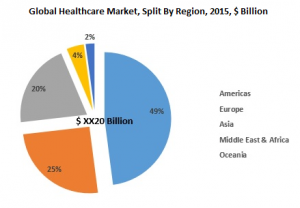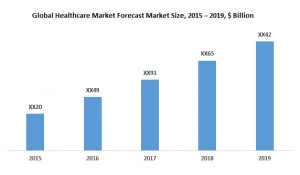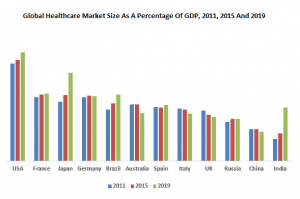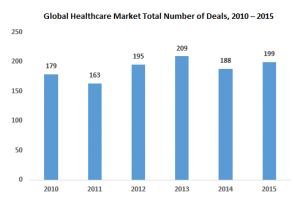Healthcare Global Market Analytics Report 2016, Including: Healthcare Services, Pharmaceutical, Medical Equipment
Healthcare Global Market Analytics provides strategists, marketers & senior management with the critical information to assess the global healthcare sector.
The total value of the healthcare sector globally in 2015 was around $8500 bn. The dominance of generics post the loss of drug patents has negatively impacted the growth of the overall market by value
LONDON, GREATER LONDON, UK, June 8, 2016 /EINPresswire.com/ -- "Digitalization of information related to patients including their medical history, diagnoses, medications, treatment plans, immunization dates, allergies, radiology images, and laboratory and test results is being made possible with Electronic Health Records (EHRs)(http://goo.gl/VIDd2o). EHRs increase patient participation, and improve diagnostic and treatment outcomes"— The Business Research Company
1. Market Characteristics
The healthcare industry is one of the largest and fast growing industries in the world, and it has a direct effect on the quality of life of patients. The term healthcare refers to diagnosis, treatment, and prevention of disease or illness, and other physical and mental impairments in humans and animals. The healthcare industry provides products and services to treat patients with curative, preventive, rehabilitative or palliative care.
Healthcare products which mainly include drugs and medical equipment(http://goo.gl/VIDd2o) are manufactured by several companies and are approved by regulatory authorities. Healthcare services are delivered by practitioners in medicine, chiropractic, dentistry, nursing, pharmacy, allied health, and other care providers. The provision of healthcare services can be either from private profit-making providers, or managed and funded by government agencies.
Access to healthcare varies across countries. It is largely influenced by social and economic conditions as well as the health policies. Each country has specific policies and plans in relation to the personal and population-based health care goals. According to World Health Organization (WHO), a well-functioning health care system requires a robust financing mechanism, a well-trained and adequately-paid workforce, reliable information(http://goo.gl/VIDd2o) on which to base decisions and policies, and well maintained health facilities and logistics to deliver quality medicines and technologies.
2. Market Size And Comparisons
The total value of the healthcare sector globally in 2015 was around $8500 billion(http://goo.gl/VIDd2o). Related to a world population of more than 7.3 billion in 2015 this equates to about $1200 per person per annum. Within the overall healthcare sector, pharmaceuticals market accounts for 18%, medical equipment market accounts for 8% and the remaining 74% is contributed by the healthcare services market. Given that World Domestic Product was approximately $73.5 trillion in 2015, the market makes up about 15% of the global economy.
The healthcare market outlook in terms of expenditure, accessibility and delivery is highly varied in parts of the world. According to the Economist Intelligence Unit (EIU), healthcare spending was highest in North America and lowest in African regions.
Rapid urbanization, lifestyle changes and increase in life expectancy has increased the disease burden of many acute and chronic diseases. The increase in incidence and prevalence(http://goo.gl/VIDd2o) rates of various diseases is increasing demand for healthcare. The healthcare industry is currently undergoing a phase of globalization, Including the adaptation of global products or services to accommodate the needs of people in a specific locale.
3. Historic (2011-2015) Drivers on the Market
i. Aging Populations – The population profile of most countries is becoming older. During the period from 2010 to 2015 the number of people globally over the age of 65 grew from below 450 million(http://goo.gl/VIDd2o) to approximately 550 million, an increase of 22%, according to estimates based on Population Reference Bureau data. The increase in the aging population has increased the patient pool of many chronic diseases such as rheumatoid arthritis, hypertension, diabetes and cancer. The increase in the patient pool has increased the demand for both healthcare services and products, significantly impacting market growth during this period.
ii. Emerging Markets Growth – According to the World Bank, the world’s middle class population – defined as that earning between $10 and $100 per day – increased from approximately 1.5 to 2 billion(http://goo.gl/VIDd2o) between 2010 and 2015. This change was driven mainly by growth in the emerging markets such as China and India. In these countries increases in disease awareness through improved diagnosis led to an increase in the use of drugs and other healthcare services. The growth in the emerging markets drove the global healthcare market during this period.
3.1 Restraints on the Market
i. Patent Expiration of Drugs – Most drugs are patented for a period after their launch during which time they can only be produced by the company which developed them. The dominance of generics post the loss of drug patents(http://goo.gl/VIDd2o) significantly decreased the average price of the drugs ought and negatively impacted the growth of the overall market by value. Some of the major patent expires which occurred include during this period include:
• Major patent expires in 2010: Eli Lilly’s Gemzar, Sanofi’s Taxotere, GlaxoSmithKline’s Epivir, and Abbott’sTarka.
• Major patent expires in 2011: Pfizer’s Lipitor, Takeda’s Actos, Bristol-Myers Squibb’s Avapro, Novartis’ Femera, and AstraZeneca’s Seroquel.
• Major patent expires in 2012: Merck’s Singulair, Novartis’ Diovan and Exforge, Pfizer’s Viagra, GlaxoSmithKline’s Avandamet, Forest Laboratories’ Lexapro, AstraZeneca’s Atacand.
4. Forecast (2015-2019) Drivers on the Market
i. Increase In Healthcare Access - Access to healthcare services is expected to improve in the developing countries. Effective implementation of health plans is the core reason for the improvement in healthcare access in many developing regions such as India, China and many Latin American countries.
Some of the country-specific health reforms which are set to improve healthcare access are China’s Urban Resident Basic Medical Insurance and New Rural Cooperative Medical Insurance schemes; Brazil’s Unified Health System(http://goo.gl/VIDd2o) and Mexico’s Popular Health Insurance.
ii. Technology – Technology is expected to continue as a driver of healthcare market growth during this period. Areas of particular development are likely to be transport, wearable technologies, robotics, and networking. Sectors such as this one will benefit from the greater efficiencies offered by these technologies.
4.1 Restraints on the Market
i. Patent Expiries – Many widely used drugs are set to lose patent in the forecast period. Patent expiry allows the launch of low-priced generics which will check the growth of market value. Some of the widely used premium priced drugs(http://goo.gl/VIDd2o) which are set to lose patent in the forecast period include: AbbVie’s Humira, Abilify, and GlaxoSmithKline’s Advair Bristol-Myers Squibb’s.
ii. Cost - Cost is the biggest health care issue facing most countries. Pressure to contain costs and demonstrate value is widespread. Political uncertainty and persistent economic stress in numerous countries are calling into question the sustainability of public health care funding. Also, the high cost of targeted therapies, personalized medicine, genetic-based medicine, medical devices, and other advances continues to add to the health care cost burden along with the impact of waste, fraud, and abuse.
5. Healthcare Market Comparison With Other Markets
The healthcare market was the largest of the markets like services, social services, IT, hospitality, transportation, professional services and recreation in 2015, accounting for around $8500 billion(http://goo.gl/VIDd2o). It uses services of physicians, healthcare professionals and procures surgical equipment and other equipment from medical equipment companies to offer services to individuals dealing with medical conditions. It is one of the world’s largest service industries, offering a range of crucial services from practitioners who are generally highly trained and regulated, leading to relatively high costs in most developed markets.
6. Healthcare Market Geography Split
The Americas were the largest geographic market(http://goo.gl/VIDd2o). in the healthcare market in 2015, accounting for $4500 billion or 55% of the global market. Americas is the largest market because of a large elderly population, increase in number of people affected with chronic diseases such as heart disease, stroke, cancer, chronic respiratory diseases, diabetes, and mental illness.
Europe was the second largest geographic market, accounting for around $2000 billion or 20% of the global market.
Asia was the third largest geographic market, accounting for around $2000 billion or 15% of the global market.
"Introduction Of Healthcare Schemes - Governments of many countries are implementing national health schemes (NHS). The effective implementation of NHS schemes especially in the developing countries(http://goo.gl/VIDd2o). is improving healthcare access in many countries. Implementation of healthcare schemes positively impacts the overall healthcare industry"
7.Healthcare Market Segmentation
The market segments in the healthcare sector as of 2015 were healthcare services, pharmaceutical and medical equipment(http://goo.gl/VIDd2o). Healthcare services was the largest segment in the healthcare sector with a 75% share of the global market. Pharmaceutical was the second largest segment with 15% of the healthcare market. Medical equipment was the third most important segment with 10% of the market.
8. Healthcare Competitive Landscape
The leading competitors in the global healthcare market are McKesson, National Health Service, United Health Group, CVS Health and AmerisourceBergen. The healthcare market is fragmented(http://goo.gl/VIDd2o). The top five competitors in the market made up only 8% of the total market in 2015. McKesson was the largest competitor with 4% of the market, followed by National Health Service, United Health Group, CVS Health and AmerisourceBergen.
9. Healthcare Industry Comparison With Macro Economic Factors
i. Healthcare Market Size, Percentage Of GDP, Global
The global healthcare market registered a compound annual growth rate (CAGR) of around 5% from 2011 to 2015(http://goo.gl/VIDd2o), while its percentage share in global GDP slightly increased from 12% to 16% during the same period healthcare market grew slightly faster than global GDP because of increases in government healthcare expenditure in emerging countries, rising lifestyle diseases and elderly populations.
During the forecast period the global healthcare share of global GDP is expected to decrease by 0.5%(http://goo.gl/VIDd2o) indicating that the global healthcare market is expected to have a slightly slower growth rate than global GDP.
ii. Per Capita Average Healthcare Expenditure, Global
Global per capita healthcare consumption grew from $1000 in 2011 to $1200 in 2015 at a CAGR of 5% and is expected to grow to $1400 in 2019 at a CAGR of 4%. Increasing per capita spend on healthcare reflects higher per person consumption generally, especially in the emerging economies. In addition the development of new technologies(http://goo.gl/VIDd2o), and longer treatment periods of those with chronic diseases is continuously increasing the cost of healthcare globally.
Buy Now
• Healthcare Global Market Analytics Report is a detailed report giving a unique insight into this market. The report is priced at $2000 for an individual user. To use across your office the price is $3000 and $4000 if you wish to use across a multinational company.
• Clients are able to input on the design of the report and highlight points of special interest.
About The Business Research Company
Visit TheBusinessResearchCompany.com or call +447443439350 or +918897263534 for more information on this and many other titles.
The Business Research Company is a market research and intelligence company which excels in company, market and consumer research. It has research professionals at its offices in the UK, India and the US as well a network of trained researchers globally. It has specialist consultants in a wide range of industries including manufacturing, healthcare, financial services and technology.
The Business Research Company's management have more than 20 years of varied business research experience. They have delivered hundreds of research projects to the senior management of some of the world's largest organizations.
The Business Research Company's Consultants have master’s qualifications from top institutes and include MBAs, MSCs, CFAs and CAs. The Business Research Company's Consultants gain training and qualifications from the Market Research Society and are trained in advanced research practices, techniques, and ethics.
Dinesh Kumar
The Business Research Company
+918897263534
email us here
Legal Disclaimer:
EIN Presswire provides this news content "as is" without warranty of any kind. We do not accept any responsibility or liability for the accuracy, content, images, videos, licenses, completeness, legality, or reliability of the information contained in this article. If you have any complaints or copyright issues related to this article, kindly contact the author above.





